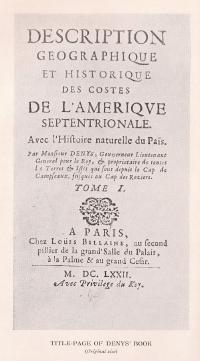Nicholas Denys

Nicholas Denys (diarist, historian, trader, and logger) was born in 1598 in Tours, France and was one of the earliest French settlers in what was then the large Maritime territory called Nova Scotia. His parents were Marie (Cosnier) and Mathurin Denys, who served as the Captain of the Royal Guard of King Henry III of France. Denys had one surviving sibling, Simon, who would later join his brother in the New World. He was also accompanied by his wife, Marguerite (de la Faye). The couple had several children (the exact number is unknown).
Little is known about Denys’ early life, though it is assumed that he was poorly educated, for he makes several apologies throughout his accounts for his improper grammar and use of language. Denys first came to the New World in 1632. In what is now known as Riverport, Nova Scotia, he set up a woodworking factory. He was later joined by his brother Simon, who assisted him in developing several lines of work, including a fishery and trade enterprise. Due to a conflict with the lieutenant-governor of the colony, the brothers returned to France, sorted out their difficulties, and received a tract of land in Chaleur Bay, northern New Brunswick. Denys set up numerous trade relationships with natives in the area. After a fire destroyed his home in 1669, he permanently relocated his family to what is now Bathurst.
Denys’ only book was Description géographique et historique des costes de l’Amérique septentrionale: Avec l’histoire naturelle du païs, which was published in two editions. When first published in 1672, Denys was in his mid-seventies. The book comprises the numerous journal articles and observations made by Denys over the years. Capturing his views of landscape and the history of the New World (primarily New Brunswick and Nova Scotia), the book provides a valuable early record of economics, culture, and white/native relationships in the colonies. Most importantly, it does this from an Acadian point of view. The book was limited to a French audience for several centuries until William F. Ganong, a New Brunswick historian, undertook the task of translating it from the old French into English. The translation was published by The Champlain Society in 1908. This single-volume edition includes maps, factual corrections, original documents, and a brief biography of Denys. The English version is entitled The Description and Natural History of the Coasts of North America (Acadia).
Though Denys only published one book, his mark was made on New Brunswick. His work provides contemporary readers with an accurate portrayal of early Acadian life. The translation of the book was also important in providing New Brunswickers with a non-Loyalist perspective on their history. Denys spent his final days in Bathurst, New Brunswick, where he died in 1688.
Brittany Black, Winter 2008
St. Thomas University
Bibliography of Primary Sources
Denys, Nicolas. Description and Natural History of the Coasts of North America (Acadia). Trans. William F. Ganong. 1908. New York: Greenwood Press, 1968.
---. Description géographique et historique des costes de l’Amérique septentrionale: Avec l’histoire naturelle du païs. Paris: Chez Claude Barbin, 1672.
Bibliography of Secondary Sources
Francis, Margret. “The Strange Career of the Canadian Beaver: Anthropomorphic Discourses and Imperial History.” Journal of Historical Sociology 17.2 (2004): 209-239.
Griffiths, Naomi Elizabeth Saundaus. From Migrant to Acadian: A North American Border People, 1604–1755. Montreal & Kingston: McGill-Queen's UP, 2005.
McLeod, Carol. “Trials and Torment: The Story of Two Stalwarts.” Nova Scotia Historical Quarterly 9.1 (1979): 37-46.
Nicholas Denys’ First Account of the Mi’kmaq. 2008. Pictou-Antigonish Regional Library. 14 Nov. 2008
<http://www.parl.ns.ca/nicolasdenys/>.
Nicholas Denys Museum. 2004. St. Peter's Community Club, Isle Madame Historical Society. 16 Nov. 2008
<http://imhs.ca/>.


